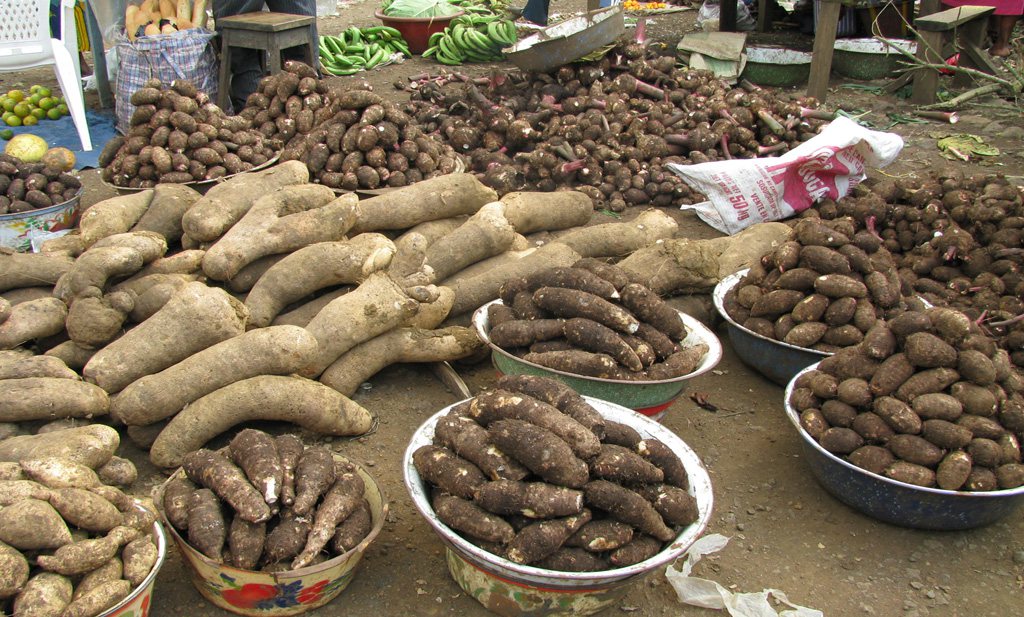Aside from cassava, yam is the most important root and tuber crop in Africa with extensive potential to sustain food security in the regions of Southeast Asia and the Pacific, as well as the tropical Americas.
Yam is an important staple throughout humid and semi-humid tropical Asia and the Americas. Its prominence as an arable crop is intricately linked to its substantial contribution to dietary protein and wide consumption especially in West Africa and the Caribbean as an important delicacy. At present, more than five million people in yam-growing countries directly depend on the yam value chain for their food security and livelihoods. The projections of roots and tubers reveal an increase from 1 million tonnes to 43 million tonnes by 2050 with per capita consumption being around 150kg per capita per year.
Production
According to the International Institute of Tropical Agriculture (IITA), most of the global production (90%) takes place in West Africa comprising Cameroon, Nigeria, Benin, Togo, Ghana, and Côte d’Ivoire. However, Nigeria is by far the world’s largest producer of yams, accounting for over 70–76 percent of the world’s production. Yams are mainly grown in tropical and subtropical climates but are native to tropical regions of Asia and Africa. They grow optimally in well-draining, loose, deep, fertile soils with a pH between 5.5 and 6.5 in full sun or part shade. They are used for several purposes in different parts of the world and are consumed after cooking by frying, boiling, or roasting. The green parts of some plants can be cooked and consumed as a vegetable while yams may also be largely used to produce flour or starch.
Food security
Generally, yams are regarded as underutilized species – plant species traditionally used for their food, fiber, fodder, oil, or medicinal properties but have been overlooked by scientific research and development workers – in Africa and all over the world. These plants risk falling into disuse, yet they play a crucial role in food security, income generation, and the culture of the rural poor. In the case of Yam, which is a very important crop for food security because of its excellent storage properties – it stores for four to six months without refrigeration – and provides an important food safety net between growing seasons. This becomes more expedient as about 1.2 billion people in the world do not have enough food to meet their daily requirements. Yam can be effectively utilized to meet the increasing demand for food and nutrition, medicines, and industrial needs. The crop has the potential to address hunger and poverty if measures are taken to acquire and distribute technological innovations that can convey yam into a focal point in food policies across countries.
One key constraint is the inefficient traditional methods of yam production which require farmers to save a minimum of a third of their harvests for the following planting season. Tackling the challenges of traditional yam production could be a giant step toward improving the food security of resource-poor yam farming households by improving the production system, especially in sub-Saharan Africa. The value chain development of yam represents an opportunity to diversify farming systems, ensure food security and alleviate poverty, while increasing income levels and improving human health. Policy implementation to drive the development of agribusiness enterprise on yam would be instrumental in positioning Nigeria, and by extension Africa, for the future yam market on a global scale.
Production
According to the International Institute of Tropical Agriculture (IITA), most of the global production (90%) takes place in West Africa comprising Cameroon, Nigeria, Benin, Togo, Ghana, and Côte d’Ivoire. However, Nigeria is by far the world’s largest producer of yams, accounting for over 70–76 percent of the world’s production. Yams are mainly grown in tropical and subtropical climates but are native to tropical regions of Asia and Africa. They grow optimally in well-draining, loose, deep, fertile soils with a pH between 5.5 and 6.5 in full sun or part shade. They are used for several purposes in different parts of the world and are consumed after cooking by frying, boiling, or roasting. The green parts of some plants can be cooked and consumed as a vegetable while yams may also be largely used to produce flour or starch.
Yam is a very important crop for food security
Food security
Generally, yams are regarded as underutilized species – plant species traditionally used for their food, fiber, fodder, oil, or medicinal properties but have been overlooked by scientific research and development workers – in Africa and all over the world. These plants risk falling into disuse, yet they play a crucial role in food security, income generation, and the culture of the rural poor. In the case of Yam, which is a very important crop for food security because of its excellent storage properties – it stores for four to six months without refrigeration – and provides an important food safety net between growing seasons. This becomes more expedient as about 1.2 billion people in the world do not have enough food to meet their daily requirements. Yam can be effectively utilized to meet the increasing demand for food and nutrition, medicines, and industrial needs. The crop has the potential to address hunger and poverty if measures are taken to acquire and distribute technological innovations that can convey yam into a focal point in food policies across countries.
One key constraint is the inefficient traditional methods of yam production which require farmers to save a minimum of a third of their harvests for the following planting season. Tackling the challenges of traditional yam production could be a giant step toward improving the food security of resource-poor yam farming households by improving the production system, especially in sub-Saharan Africa. The value chain development of yam represents an opportunity to diversify farming systems, ensure food security and alleviate poverty, while increasing income levels and improving human health. Policy implementation to drive the development of agribusiness enterprise on yam would be instrumental in positioning Nigeria, and by extension Africa, for the future yam market on a global scale.
Related



